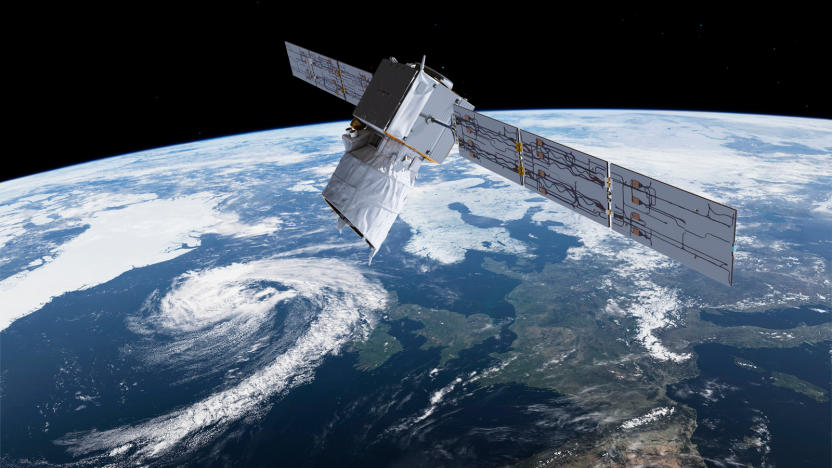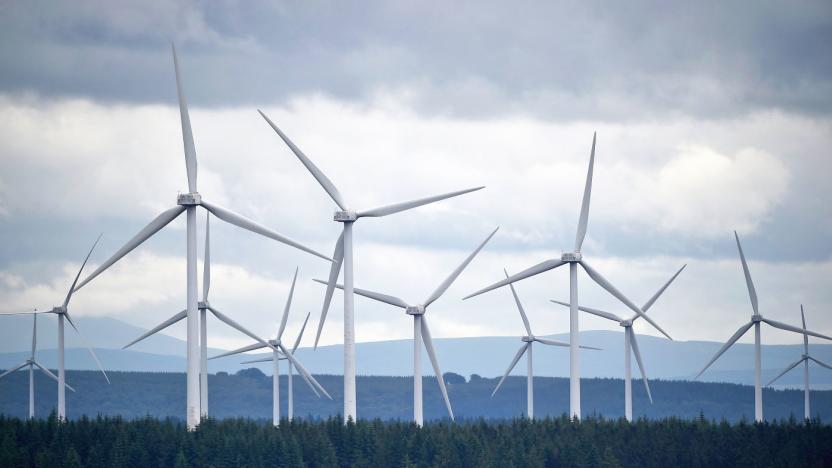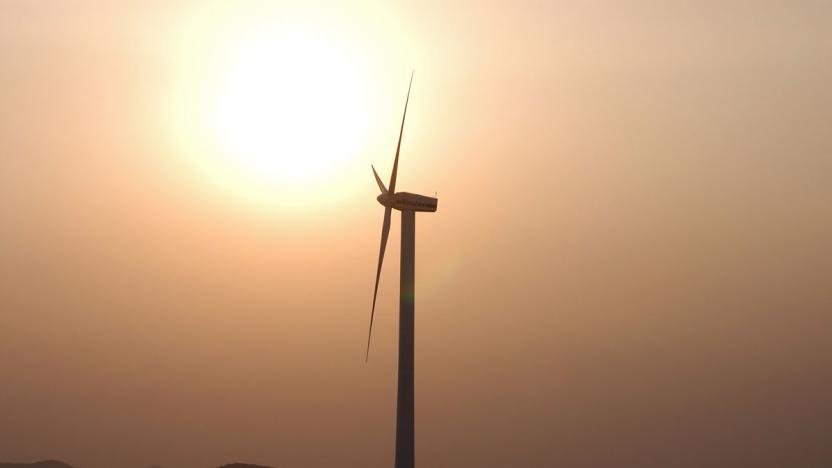Wind
Latest

Europe's cutting-edge wind satellite should launch in 2017
Humanity is about to deepen its understanding of Earth's winds. The European Space Agency has secured a rocket launch deal for its wind-tracking Aeolus satellite, which is now expected to enter orbit before the end of 2017. The once-problematic spacecraft (technical issues postponed its 2015 launch) will be the first to profile wind on a worldwide scale thanks to the novel use of ultraviolet lidar in space. By bouncing laser light off of atmospheric air, dust and water, Aeolus will measure everything from cyclones to the presence of aerosols.

World's largest offshore windfarm to be built in the UK
Britain is set to become home to two of the world's largest offshore wind farms after ministers approved plans for a new 1,800-megawatt project capable of supplying 1.8 million UK homes. Hornsea Project Two will be built 55 miles off the coast of Grimsby and could feature up to 300 turbines -- each one taller than the Gherkin building in London.

ESA plans to study the wind by shooting lasers from space
The European Space Agency plans to send two potent Aladin lasers into space next year, both aimed at studying the wind. It's part of the ESA's Living Planet program aimed at better understanding hugely influential natural phenomena, like magnetism and wind. This time, it's concerned with the latter.

Harvard's battery tech takes cues from vitamin B2
A team of Harvard scientists on a quest to find an organic molecule that can be used to make non-toxic, low cost flow batteries found their answer in vitamin B2. By making just a couple of tweaks to riboflavin's original molecule, which converts carbs to fuel in our bodies, they were able to design one that can be used to store energy harnessed by solar and wind sources. The same team previously worked on a battery that uses a type of organic molecule called quinones and ferrocyanide (a food additive) instead of typical electrolyte. They decided to find other molecules that could lead to a version with better capacity, however, and were inspired by B2's capabilities.

England isn't windy enough for new turbines, claims industry boss
Every country has its stereotypes, but England will always be famous for its terrible weather. You'd think a land labeled for its cold, wet and windy conditions would be ideal for generating energy, but it turns out that isn't the case. The head of the UK's wind industry trade body, Hugh McNeal, has even gone on record to admit that England simply isn't windy enough to justify the creation of any more wind farms.

6 high-tech, energy-generating roads
By Cat DiStasio As we march into toward the future, our infrastructure needs to evolve. Fortunately, innovators are integrating energy-generating properties into the very roads that lead us forward. Solar panels can now be applied directly to a road's surface and driven over countless times before showing any signs of wear. Other next-gen roads automatically melt snow, reduce noise pollution, and even delight the public with artistic inspiration. Follow along for a trip around the world on pathways that generate clean energy for the communities they connect.

Mechanical 'trees' generate energy by swaying in the wind
What if windmills looked more like trees? Well, a team of engineers at Ohio State University is looking for answer to that question with structures that resemble trees, but actually create energy when they move in the breeze. That swaying motion from the wind, and the resulting structural vibrations, is converted into electricity with electromechanical materials such as polyvinylidene fluoride (PVDF). The project isn't merely concerned with those tree-like structures, though. It also looks to harvest the energy generated from the vibrations of buildings and bridges.

Canadian cable company Shaw just bought a phone network
Shaw Communications has announced that it's going to pay $1.6 billion CAD for Canuck carrier Wind Mobile. As MobileSyrup reports, there were rumors of a Verizon purchase back in 2013, but the US carrier ended up courting some internet company or something. Shaw will pick up Wind's mobile spectrum that covers Ontario British Columbia and Alberta. CEO Brad Shaw says the company plans to offer converged network solutions, which is the unsexy way of saying Canadians will be able to bundle their wireless needs in with their cable and internet -- if they like what Shaw's offering. The deal still needs to pick up approval from Canada's Competition Bureau, but Shaw expects the deal to go through by late 2016.

Google makes big clean energy purchase to power data centers
Powering Google's online empire takes a lot of energy, and the company wants to use all clean sources to run its data centers by 2025. The company announced the next step towards that milestone today with word that it purchased 842 megawatts of renewable energy on three continents. The purchase includes solar and wind power in locales that range from North Carolina to Chile and Sweden, doubling what it had bought so far. Google says today's announcement is the largest purchase of clean energy by a non-utility company ever.

Apple invests in more clean power for Chinese manufacturing
It's no secret that Apple takes its energy responsibilities seriously. It already powers a large percentage of its buildings via renewable sources, but ensuring that its manufacturing facilities run on clean energy isn't as easy, especially when it has partners located in various different regions. China is now Apple's fastest growing market, but it's also where the majority of its products are assembled, so it's embarking on two new programs to improve its environmental impact in the country.

Google invests in Africa's largest wind power farm
Google's big bet on clean energy isn't just limited to the US or Europe -- far from it. The search firm just promised to invest in Africa's largest wind farm, the Lake Turkana Wind Power Project in Kenya, by buying turbine maker Vestas' 12.5 percent stake when the farm is complete. Lake Turkana should generate 310MW of energy when all is said and done, or as much as 15 percent of Kenya's current output. That could not only help the country transition to green energy sources, but give it the kind of reliable electricity that's tough to find in the region.

Inhabitat's Week in Green: 'Iron Man' prosthetics and a creepy Airbnb
Each week our friends at Inhabitat recap the week's most interesting green developments and clean tech news for us -- it's the Week in Green. Want to see the state of the art in solar-powered architecture? Check out eight of the world's most efficient sun-powered homes built by students for the 2015 Solar Decathlon. In other solar news, Panasonic just shattered a world record by building the most efficient photovoltaic panel on the planet. A Dutch firm recently announced plans to build the largest wind farm in Africa near a remote Kenyan lake. And Washington, DC, unveiled the world's largest waste-to-energy system, which will generate electricity from the city's raw sewage.

Inhabitat's Week in Green: 3D-printed pavilions and cardboard cars
Each week our friends at Inhabitat recap the week's most interesting green developments and clean tech news for us -- it's the Week in Green. What will the homes of the future look like? If this year's Solar Decathlon is any indication, they will be self-sufficient, hyper-efficient and 100 percent powered by the sun. How about a home that grows all the food you need, so you never need to take a trip to the produce aisle? Or a super-durable disaster-proof house that's strong enough to fight tornadoes and win? However, the coolest one might be this tiny home that can be emailed to a woodshop across the world, CNC cut and then assembled like a giant puzzle without a single nail.

Clean energy is nearly as inexpensive as coal and gas
One of the biggest obstacles to adopting solar or wind power is simply the cost of getting started. However much an electricity company might save in the long run, that up-front expense is tough to swallow. Or rather, it was -- Bloomberg New Energy Finance study has found that the cost of clean energy has dropped so much that it's within spitting distance of dirty sources like coal and gas. The global average cost of onshore wind power has dipped to $83 per megawatt-hour, while silicon solar power now costs $122. Neither of those figures is trivial, but they're not much different than what firms pay for coal (which has risen to $75 per MWh in the Americas) or gas turbines ($82 per MWh). Some green tech is still expensive, such as offshore wind ($174) and marine ($400-plus), but prices have fallen there, too.

Inhabitat's Week in Green: the Model X and man-made islands
Each week our friends at Inhabitat recap the week's most interesting green developments and clean tech news for us -- it's the Week in Green. After three years of anticipation Tesla just launched its latest electric car. The company says the Model X is the world's safest SUV; it can go from 0-60 in 3.2 seconds; and it comes with a "bioweapon defense mode" in case of... well, the apocalypse. Meanwhile the Volkswagen emissions scandal continues to develop, and this past week, we asked just how many people have died due to pollution emitted by affected vehicles. Perhaps the worst part is that Volkswagen may actually avoid criminal charges due to a loophole in the Clean Air Act.

Inhabitat's Week in Green: Off-grid homes and fold-up planes
Each week our friends at Inhabitat recap the week's most interesting green developments and clean tech news for us -- it's the Week in Green. What does it take for a house to go completely off-grid? A diverse range of energy sources is key -- and this new 3D-printed house can be powered by built-in solar panels or tethered to a hybrid car. We also love this pop-up transparent dome shelter that lets you sleep beneath the stars. In other architecture news, Apple just launched its first store under the guidance of Jonathan Ives -- and it's warmer and more curvaceous than the company's previous brick and mortars. MAD Architects unveiled out-of-this-world plans for a futuristic George Lucas Museum in Chicago. And a team of researchers found a way to build a functional 24-foot rope bridge using drones.

Inhabitat's Week in Green: hypersonic jets and spider cars
Each week our friends at Inhabitat recap the week's most interesting green developments and clean tech news for us -- it's the Week in Green. Airbus just unveiled its vision for the future of transportation: a 3,000MPH airplane that could travel from New York City to London in one hour flat. Meanwhile Lexus brought the future to life by debuting a working hoverboard that can soar through the air and fly over water. Tesla turned heads with an automatic electric car charger that looks like a robotic snake, while Swincar launched an amazing off-road spider car that can tackle any terrain. Stanford brought us one step closer to a solar future by revealing its new Arctan sun-powered vehicle, and China debuted an all-electric bus that can charge up in 10 seconds flat.

Inhabitat's Week in Green: Facebook drones and giant slides
Each week our friends at Inhabitat recap the week's most interesting green developments and clean tech news for us -- it's the Week in Green. Tesla's Model S got a lot of press when Elon Musk unveiled a "Ludicrous" upgrade that goes from 0-60 in 2.8 seconds -- but a new car built by a team of German students can go even faster than that. The electric vehicle can accelerate from 0-62MPH in a blistering 1.779 seconds, and it's currently awaiting confirmation for a Guinness World Record. In other news, Facebook just unveiled a solar-powered airplane that will beam the internet to remote locations. The Aquila has the wingspan of a Boeing 737, yet it weighs less than 1,100 pounds. This week, Inhabitat reporter Marc Carter spotted Chrysler's camouflaged new Town & Country minivan on the streets of LA -- and it looks like it's going to be a plug-in EV. Google's Street View cars show us towns and cities throughout the world -- and now they're getting equipped with pollution sensors to monitor the air we breathe. And if you're planning a road trip this summer, we've got two amazing mobile dwellings for you to check out: a stylish wood cabin on wheels and an old-school bus that's been retrofitted into a remarkable little home.

Inhabitat's Week in Green: cliffside homes and The Bark Knight
Each week our friends at Inhabitat recap the week's most interesting green developments and clean tech news for us -- it's the Week in Green. What if your car was powered by sunlight? It sounds like a dream come true -- but that's exactly what a team of Dutch engineering students have cooked up. The Stella Lux is a four-seater electric car with a powerful solar roof that actually generates more energy than the vehicle uses. In other futuristic transportation news, Local Motors just unveiled plans for the world's first production line of 3D-printed cars. The ultra-customizable vehicles include a sporty racer and a beach-ready buggy. Automakers and tech companies around the world are fervently working on self-driving cars, and it turns out the technology could be a tremendous boon for the environment. A new study shows that autonomous robocabs could cut greenhouse gas emissions by 94 percent. And this week, two electric airplanes made history by successfully flying across the English Channel.

UK government pulls support for new onshore wind farms
In the future, there's a good chance you'll see fewer wind farms being erected in the British countryside. That's because the UK government is killing a subsidy scheme that gives onshore wind farms a helping hand when they sell their electricity to energy suppliers. Under the Renewables Obligation (RO) order, Ofgem currently awards wind farms special certificates based on the amount of electricity they generate. They then sell these to the UK's energy providers, earning a premium on top of their normal wholesale prices.






